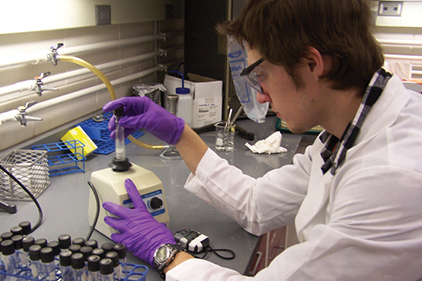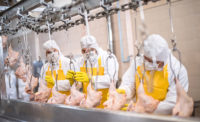In one of the larger food recalls to date, this summer Cargill Meat Solutions voluntarily recalled about 36 million pounds of ground turkey meat on fears it was contaminated with Salmonella bacteria, possibly the drug-resistant Salmonella Heidelberg strain.
The company also halted production at its Springdale, Ark., plant for a few weeks until the source of the strain was discovered. The cause? Sanitary concerns, which were addressed by improving antibacterial technology in the chilling system, adding antibacterial sprays in the harvest line and requiring Springdale meat suppliers to include Cargill’s antibacterial technology in the harvest process.
Indeed, that is the purpose of clean-in-place (CIP) and open-plant-cleaning (OPC) systems, which certainly play an essential role in the production process, but have remained largely unchanged for at least a decade — if not 40 to 50 years.
The Cargill recall brings renewed attention to this critical process as bacteria strains become more wily and resilient. In the meantime, the meat and poultry industry continues to grapple with balancing food safety with environmental issues, water costs and availability, energy costs, and centralized, highly complex food-processing facilities with wide distribution.
“Historically, processors have been more concerned that their equipment has the proper function, throughput and worker safety, and cleanability has been an afterthought in some cases,” says Kevin Keener, Ph.D., professor of food science, Purdue University, based in West Lafayette, Ind. “Because of recent outbreaks that may have been associated with equipment not being properly cleaned, such as in the cracks and crevices, there is more of a movement under way — especially after the Food Safety Modernization Act was passed — to examine if machines are getting clean down to the microbial level.”
CIP vs. OPC
CIP is geared toward industries that require frequent internal cleaning of their processes in closed spaces, such as in meat, dairy, beverage and brewing plants. With CIP, meat processors can clean the interior surface of pipes, vessels, process equipment, filters and associated fittings without disassembly through recirculating pipelines. A typical CIP system might include a solution reservoir, a supply pump and a return circuit. Or, a tank or other type of vessel, a spray device and some type of return device are used.
As a result, the cleaning process should be faster, less labor intensive and more repeatable, with less risk of chemical exposure to employees. To enhance the effectiveness of the cleaning process, elevated temperatures and chemical detergents are commonly used, as well.
OPC, on the other hand, is a manual cleaning practice, usually involving sanitizer and elbow grease, for large, open spaces.
“CIP is a big investment at first, but the pumps are pretty stable and require only regular maintenance,” says Steven Goodfellow, Ph.D., director of technical services, Deibel Laboratories, based in Gainesville, Fla. “However, smaller processors generally don’t do clean-in-place, just the big ones.”
If CIP is done right, it stands little chance of recontamination because it is a closed system, he says. However, if a part does become contaminated, the bacteria will be hard to get rid of because CIP systems are not meant to be taken apart.
“Most of its challenges revolve around its basic construction,” he says. “Once CIP systems are put together, processors can’t assume they are clean and sanitized, because there are still unsealed areas and cracks that product can hang around.”
Deconstructing the pieces
West Liberty Foods uses both CIP and OPC methods for its operations.
“Certain applications dictate whether we use CIP or OPC, but the vast majority of our plants use OPC. Anything that can generate robust cleaning water is key,” says Lee G. Johnson, Ph.D., vice president of technical services, West Liberty Foods, noting the ability to be able to dissemble and clean equipment with CIP is important.
For example, West Liberty Foods uses CIP for the pipes and closed systems in its slaughter plants, he says.
To reach the nooks and crannies in its meat and ready-to-eat meat equipment, West Liberty Foods will also put the equipment parts in CIP tanks, which use heat and detergent.
“Also, we put logs through slicers so there are lots of nooks and crannies in equipment that need to be scrubbed, torn apart and cleaned,” he says. “The ability to take slicing equipment apart so it can be cleaned and put back together is big for us, and will lead to continued strong food-safety results.”
Johnson notes it’s also critical to fit the CIP piping and delivery systems accurately, so the pumps don’t leak, the heat is right and the pipes don’t become blocked with hard debris.
“A big challenge is the fact that there isn’t one solution for meat plants so they can do the vast majority of their cleaning with just CIP,” he says. “If equipment manufacturers can figure out how to do open areas with CIP, that would save time and money.”
New cleaning methods
Processors are always looking at ways they can gain more access to their processing equipment, so they can be opened more easily during OPC.
“For example, if processors could have a way to clean underneath their dicer system — by lifting it up for cleaning or clean-in-place — that would be an advantage,” says Keener.
Instilling turbulence into the CIP or OPC pump lines, in theory, should increase the scrubbing action of the cleaners, thereby requiring less chemicals and water in the system, notes Keener. However, many plants don’t utilize this procedure because of the additional costs involved during installation.
Electrostatic sprayers, while around since 1978, are receiving renewed attention for after sanitization methods because they use little sanitizers but coat an entire area.
“It’s a more cost-effective use of chemicals, provides more coverage and is better for the environment,” says Scott Russell, Ph.D., professor of poultry processing and products microbiology, The University of Georgia. “However, chemical companies don’t want clients to use them because they use less chemicals.”
Product surfaces are receiving renewed attention, as well. The European Hygienic Engineering & Design Group (EHEDG) has developed scales to measure the smoothness of equipment surfaces, due to concerns that rough areas can harbor bacteria in their cracks and crevices requiring more attention during open-plant-cleaning.
In addition, Russell notes new technologies are available that will transform plastic and metal surfaces into antimicrobial barriers to prevent biofilms from forming. This technology can be used in cutting boards, refrigerators, freezers and metal. However, the technology can’t be sprayed on; it must be incorporated into the product design from the beginning. So processors would have to replace equipment one by one with new antimicrobial-treated equipment.
“Companies have to see that this technology is cost-effective before they try it,” he says.
A chemical reaction
The last 10 years have also seen incremental improvements in the cleaning compounds used with CIP and OPC to improve their cleaning ability and shorten the length of time needed to circulate the chemicals.
Anytime processors switch to a different chemical system for cleaning and sanitizing, they run the risk of altering the processing system through corrosion or formation of biofilms, says Ronald H. Schmidt, Ph.D., retired food science and human nutrition professor, University of Florida.
“However, if the equipment is manufactured according to appropriate sanitary design criteria, these effects would be expected to be minimal,” says Schmidt. “Further, many alternative chemicals are less corrosive to equipment than the traditional chemicals.”
In fact, for the past 20 to 30 years, food industry cleaning suppliers have worked on developing more environmentally friendly detergents and systems to minimize the environmental impact of cleaning and sanitizing through reducing effluent load (BOD and pH) and by decreasing the use of chemicals that are less environmentally friendly (such as phosphates, nitrates, sodium salts and chlorine), he says.
“Single-phase or single-cycle CIP detergents are now being marketed that are designed to replace the more traditional alkaline/chlorine-based products to remove fats, minerals, and proteins in one wash cycle,” says Schmidt. “In addition to lowering the chemical discharge, such detergents also shorten the cleaning process and save on water usage.”
Many innovations in the design of cleaning systems have been developed, as well. They reduce the overall effluent load through chemical recovery systems, improving and redesigning CIP systems so they use less water and improve cleaning efficiency.
“These systems use engineering principles and evaluation methods that focus on the mechanics of the system through more efficient pump systems, piping design systems, automatic valve systems with improved sequencing and improved water flow and control, and the use of vortex breakers,” says Schmidt.
In recent years, there has been increased use of food product recovery systems where appropriate, he says. Such systems remove much of the residual food product in the system prior to cleaning, thus lowering the cleaning and sanitizing load and allowing for the use of less water and chemicals. However, disposal of the recovered product may be an issue.
“Depending upon the situation, recovered product may be used in rework or reprocessing, byproduct utilization or animal feed,” says Schmidt.
Improved monitoring of the product stream using electrical conductivity or optical methods has also resulted in less water waste in cleaning systems.
As the CIP and OPC system manufacturers continue to make incremental improvements to their systems, it’s important to remember the role employees play too.
“Equipment may function well, but if employees can’t clean it and the end result negatively impacts the company reputation, then the long-term viability of the company will be damaged,” says Keener.
|
SIDEBAR |
|
A guide to good hygiene American CIP and OPC equipment manufacturers don’t have government regulations regarding their products, beyond meat and poultry processors needing a letter of no objection from the USDA for new plant equipment, but in Europe, equipment manufacturers and users have to implement government requirements that require hygienic handling, preparation, processing and packaging of food with hygienic machinery in hygienic locations. The European Hygienic Engineering & Design Group (EHEDG) helps guide processors on what hygienic design standards are needed to comply with national and international legislation. “EHEDG is the only group in the world that will do an equipment assessment to say if it cleans and sanitizes correctly. It has seen an increase in awareness and requests recently,” says Kevin Keener, Ph.D., professor of food science, Purdue University. Companies that want to sell meat and poultry in Europe are finding that they need to re-examine their equipment, he says. In Europe, says Scott Russell, Ph.D., professor of poultry processing and products microbiology, The University of Georgia, they want their machines to be more hygienic and don’t want any chemicals in their food. “They are more afraid of chemicals in their food than bacteria,” he explains. This combination makes it difficult for American processors to sell product overseas, as they face less regulations on their equipment and use more chemicals to prevent foodborne illnesses. Still, U.S.-based organizations NSF International and 3-A Sanitary Standards Inc. are working with EHEDG to harmonize their respective guidelines and standards, which are voluntary in the United States. — Megan Pellegrini |





Report Abusive Comment